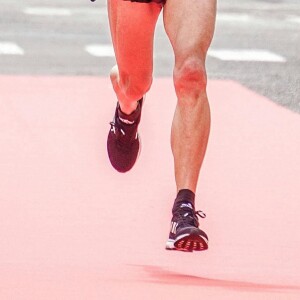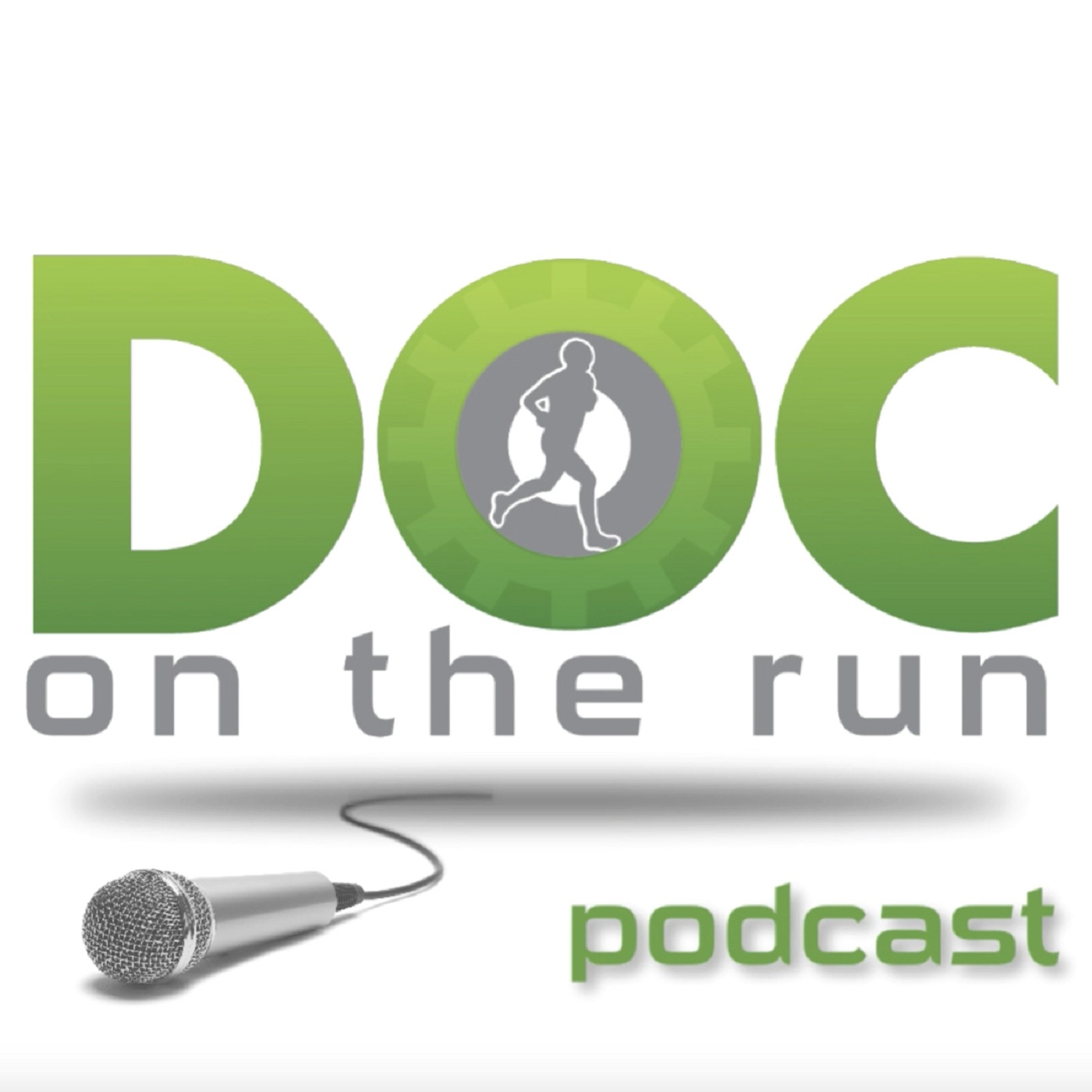Episodes

5 hours ago
5 hours ago
The biggest enemy in the injured runner’s battle is your desire to run as fast or faster than you were right before you got injured.
This morning I was on a call with a recovering elite Masters athlete and she has been doing great, but she seems to be drifting into dangerous territory!
During our call, I got worried about the way she was thinking about her upcoming workouts. But was thinking was very common, and very dangerous. And that is the reason I decided to record this episode.
Today on the Doc On The Run podcast, we're talking about how you should never let your recovering body compete with your racing body.

Thursday Nov 13, 2025
Why runners get reinjured 1 to 2 months into healing
Thursday Nov 13, 2025
Thursday Nov 13, 2025
This morning I was on a consultation call with a runner at 4:30 a.m. and he's been suffering from a plantar plate injury. But he's been doing pretty well. He actually just finished his first run!
Now, what I asked him about was his plan for his next run. What he said, made me uneasy.
It seemed risky, and I started kind of squirming as he was describing his plan to me. It wasn't really a bad plan. It wasn't really a crazy plan. But based on all the experience I have working with injured runners, I knew it was riskier than it needed to be.
And this is why I decided to record this episode. Because it happens to almost every injured runner! So don't let it happen to you!
Today on the Doc On The Run podcast we’re talking about why runners get re-injured one to two months into healing.

Friday Oct 17, 2025
Suffering solution is different with running injury
Friday Oct 17, 2025
Friday Oct 17, 2025
Runners glorify the suffering needed to keep moving in spite of pain, and the payoff is almost always increased fitness, and improvements and mental fortitude needed for running endurance.
No pain, no gain is a terrible approach when you are an injured runner. If you really want to get back to training, racing in full return to running fitness as fast as possible after a running injury you have to stop causing pain in that one injured part. Do not confuse that with stopping running-related exercise. That's the lazy doctor's way.
In this episode, we discuss a different, better approach for runners.

Monday Sep 29, 2025
Mental Rehab for Recovering Runners with Mental Skills Coach Carrie Jackson
Monday Sep 29, 2025
Monday Sep 29, 2025
Today on the Doc On The Run Podcast we are talking about Mental Rehab for Recovering Runners with Mental Skills Coach Carrie Jackson.
It may sound dramatic, but in reference to doctors casually telling runners they just cannot run a race (when maybe the runner could run), or worse…they may never run again, Carrie says, “These doctors have no idea the trauma they are causing to the runner by saying that.”
Carrie co-authored “Rebound: Train Your Mind to Bounce Back Stronger from Sports Injuries.” So, she is not just empathetic toward runners, she is 100% qualified to help runners get your mojo back after a serious injury sets you back physically, and the pain of recovery sets you back mentally.
Not only is she a Certified Mental Performance Consultant through the Association for Applied Sport Psychology, but Carrie is also the host of the Injured Athlete’s Club Podcast.
If you have an injury, and you feel down. There is a solution. Listen in to Carrie, and you will find it.

Wednesday Jul 30, 2025
50-miler injury prevention tips from Hell's Hills with Dr. Samantha Braun
Wednesday Jul 30, 2025
Wednesday Jul 30, 2025
Today on the Doc On The Run Podcast we are talking with Dr. Samantha Braun about training fro Ultra’s, running Hell’s Hills and how her training as a Physical and Rehabilitation Medicine Physician helps her avoid overtraining injuries. How do you think you're training in rehabilitation help you understand your own mechanics, physical training limits and overtraining injury prevention while training for Ultra’s? During the 50 mile trail race, what did you do to restore a more positive mindset and keep running to your potential? Knowing what you know now, what would you do differently to prevent that injury from happening? Right now there is some runner listening who is suffering from an over training injury, and very likely of how demoralized they have become as a consequence of not running. If she was sitting there in front of you right now and you knew this about her, what advice would you give her to encourage her to keep healing, working and getting stronger so that she could get back to running?

Sunday May 11, 2025
5 Critical Stress Fracture Steps for Runners
Sunday May 11, 2025
Sunday May 11, 2025
Over the past couple of months I have done a whole bunch of stress fracture strategy calls with runners who seem to be stuck. I take notes every time I do those calls and there're number of steps that all of them seem to be missing. Let's face it, if they weren't missing some critical steps, we would've never gotten on a call to try to figure out a strategy to get them back on the path to healing and running again.
In this episode I'm going to explain the five critical stress fracture steps every runner should take if they really want to get back to training and back to running as quickly as possible.
Today on the Doc On The Run podcast we're talking about the five critical stress fracture steps for runners.

Thursday Apr 17, 2025
1003 Stress Fracture Strategy for Runners Start Here
Thursday Apr 17, 2025
Thursday Apr 17, 2025
I just got off of a Stress Fracture Strategy call with a real runner who has been suffering from a stress fracture for 47 days.
Over the past five weeks she has been getting worse, not better.
And she hasn’t even been running for more than a month!
If you have a stress fracture, or a stress reaction and you are:
1. worried about canceling race because of a stress fracture
2. your stress fracture is not getting better fast enough
3. worried you're going to lose your running fitness waiting for the stress fracture to heal
This episode will help you understand the strategies I use whenever I worked directly with runners with stress fractures, and apply those strategies to help you figure out how to speed up your stress fracture recovery.

Saturday Apr 05, 2025
Saturday Apr 05, 2025
Today on the Doc On The Run Podcast we are talking with Alexandre Dufresne about his journey and getting back to running after having suffered 2 metatarsal stress fractures at same time!
If you think back about your training leading up to the 2 stress fractures, if you could go back in time, do you think there's any one thing you could have changed in your training routine that might have prevented it from developing into such a serious problem? Listen up to find out!

Thursday Mar 27, 2025
1001 Ultra Run Coach Patrick Durante on Automatic Negative Thoughts in runners
Thursday Mar 27, 2025
Thursday Mar 27, 2025
Today on the Doc On The Run Podcast we are talking with Patrick Durante about Automatic Negative Thoughts and how they affect runners.
Many years ago I was having a discussion about daily stressors with a friend of mine name Maury. He said something I have never forgotten.
“It's not the lions and tigers that will get you. It's the ants and mosquitoes because problems.”
Every single over training injury that afflicts runners as a consequence of developing too much stress. The constant buzzing of mosquitoes and ants may drive you crazy. And Today we are talking about the creepy, crawly kind of ant, but A.N.T. or Automatic Negative Thoughts that buzz through our heads and inhibit our ability to finish races on time, complete training runs in a gratifying way, and may even may inhibit our recovery from hard workouts or over training injuries.

Wednesday Mar 19, 2025
Stress Fracture Nutrition for Recovering Runners with Dr. Laura Kelly
Wednesday Mar 19, 2025
Wednesday Mar 19, 2025
If you're a runner with a stress fracture you're probably trying to figure out everything you can do right now this going to speed up healing of the injured bone, so you can get back to running as soon as possible.
If you have been thinking about bone broth or nutritional supplements like vitamin D and calcium you already know how important it is to get the nutritional building blocks into your system so your osteoblast cells can't start repairing and rebuilding the crack in the bone.
Did you know there's actually a cookbook written specifically to address the nutritional requirements four building healthy bones? Well, there is…it is called The Healthy Bones Plant-Based Nutrition Plan and Cookbook and in today’s episode I am getting to got to sit down with Dr. Laura Kelly who wrote that cookbook.

